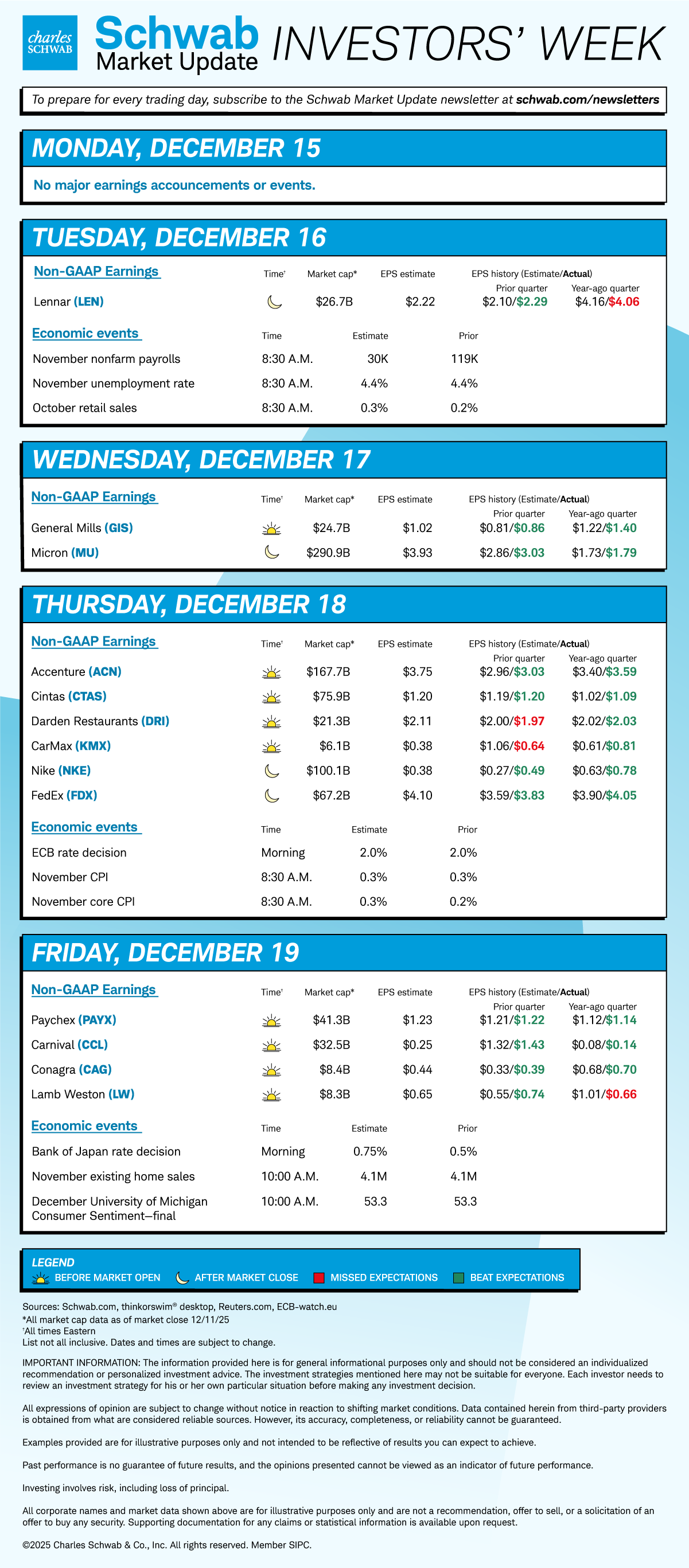After Punishing Plunge, Tech Up Before Jobs Data

Published as of: December 16, 2025, 9:14 a.m. ET
Listen to this article
Listen here or subscribe for free to the Schwab Market Update in your favorite podcast app.
| The markets | Last price | Change | % change |
|---|---|---|---|
| S&P 500® index | 6,816.51 | -10.90 | -0.16% |
| Dow Jones Industrial Average® | 48,416.56 | -41.49 | -0.09% |
| Nasdaq Composite® | 23,057.41 | -137.76 | -0.59% |
| 10-year Treasury yield | 4.18% | -0.02 | -- |
| U.S. Dollar Index | 98.19 |
-0.12 |
-0.12% |
| Cboe Volatility Index® | 16.57 | +0.07 | +0.42% |
| WTI Crude Oil | $55.71 | -$0.96 | -1.69% |
| Bitcoin | $86,850 | +$428 |
+0.5% |
(Tuesday market open) U.S. jobs growth totaled 64,000 in November and unemployment rose to 4.6%—the highest since 2021 and up from 4.2% a year ago, the government said Tuesday in its nonfarm payrolls report. Though the headline data from November didn't clash dramatically with expectations, October's massive plunge of 105,000 jobs showed a labor market that continues to struggle. Major U.S. indexes, which approached the report lower in trading before the bell, were little changed after the data and remained red, with the tech-heavy Nasdaq still down most. The dollar and Treasury yields slipped after the news.
Consensus heading into the report was for November jobs creation of 30,000 with unemployment little changed at 4.5%, so the data for that month could be read as mixed versus expectations. However, jobs growth from August and September got revised downward by a combined 33,000 before October's big drop, though the government didn't collect October unemployment data due to the shutdown that also delayed November's data. "The report shows there's ongoing weakness in the labor market," said Cooper Howard, director of fixed income research and strategy at the Schwab Center for Financial Research. "The labor market is softening but not falling off a cliff."
On Monday, stocks opened hot but quickly cooled as info tech selling carried over from last week. Big hitters like Broadcom (AVGO), Alphabet (GOOGL), Microsoft (MSFT), and Apple (AAPL) weighed down major indexes, though market breadth improved. The S&P 500 index appears to be consolidating without much conviction either way. On a positive note, it remains just 1% to 2% off all-time highs despite almost no help from tech. However, it may need tech's revival to test the all-time high of 6,920. Potential catalysts include today's jobs data, Thursday's inflation reading, and earnings from Nike (NKE), FedEx (FDX), and Micron (MU) in coming days. The path of least resistance seems higher, but an end-of-year rally isn't certain.
To get the Schwab Market Update in your inbox every morning, subscribe on Schwab.com.
Three things to watch
- Jobs report deeper dive: Sectors showing jobs growth in November included health care and construction, while federal government jobs fell. That last category came as no surprise, considering the long shutdown. However, the downward revisions to prior reports--along with the partial data for October--provide more evidence of struggle. "October was a very bad month," my colleague Howard said. "There was weakness across the board." Much of October's downturn reflected a drop in federal government jobs due to a deferred resignation program, taking that category down by 162,000, perhaps a one-time impact on the market. Generally, goods-producing areas of the economy are showing weaker jobs growth while hourly earnings rose a light 0.1% in November, but drawing broad conclusions from today's data may not be possible. "It was a fairly noisy report and will likely need a few more months of data to get a better read on the labor market," Howard said. "I think it's hard to put too much emphasis into this one."
- Eye on commodities: Metals prices continued their meteoric rally yesterday, with gold (/GC) and silver (/SI) among the big gainers. Silver alone is up about one-third from its November low set less than a month ago. Of the major commodities, crude oil (/CL) is among the few still under pressure. Rising prices for key industrial metals like copper (/HG)—possibly reflective of strong industrial demand amid data center buildouts—likely have helped materials stocks recently, though they also raise inflation worries. A sinking dollar might also be in play, especially for gold, as investors often pile into that precious metal when the dollar fades. The dollar's recent softness reflects last week's Federal Reserve rate cut and expectations for more ahead next year, along with worries about U.S. economic growth. Another possibility is that investors piled into gold and other metals in a rotation out of cryptocurrencies as they look for hard assets.
- More data on way, with yield path under scrutiny: Today also brings delayed September housing starts and building permits, along with industrial production and S&P Global U.S. manufacturing numbers, all before 10 a.m. ET. Markets could get volatile as the data emerge, and the Cboe Volatility Index, or VIX, climbed Monday following recent flirtation with three-month lows under 15. Higher volatility often accompanies pressure on stocks, and Wall Street also might see pressure if economic numbers are worse than expected. Any weakness, especially in jobs growth, could weigh on the dollar if participants start baking in a more aggressive Fed in 2026. After today's early data, chances of a rate cut next month were little changed at just above 26% according to the CME FedWatch Tool. Market participants work in two to three 2026 rate cuts, likely starting before mid-year, but the Fed's "dot plot" of rate projections last week showed just one cut anticipated. "Longer-term, we expect rates to continue to remain range bound," Howard said before the jobs data. "However, a weaker-than-expected jobs report could send yields lower due to concerns that the economy is slowing more than expected and that the Fed will cut more."
On the move
Ford (F) rose 1.4% ahead of the open after saying it expects to record about $19.5 billion in special items relating to a restructuring of its business priorities and a pullback in its all-EV investments.
Gap (GAP) rose more than 2% before the open after getting an upgrade from Wells Fargo to overweight from equal weight. The firm cited core acceleration at Gap and Old Navy.
PayPal (PYPL) rose 1.75% in early trading after the firm confirmed applications to establish PayPal Bank, according to Bloomberg.
Kraft Heinz (KHC) rose 1.6% after announcing a new CEO.
Bitcoin futures (/BTC) rebounded 1.8% this morning. They plunged 5% Monday to close below $86,000, dragging down crypto-related stocks as well. The drop in crypto accompanied upward moves in gold and other metals, possibly reflecting rotation out of cryptos and into other assets perceived as alternatives to the dollar.
Crypto-related names in the stock market rose this morning, including Circle Internet Group (CRCL) and Strategy (MSTR).
Roku (ROKU) climbed 4.8% after getting an upgrade to overweight from underweight by Morgan Stanley, which sees a "strong" 2026 for U.S. advertising spending due to digital strength.
Eight of 11 S&P 500 sectors rose Monday despite a tech-driven drop in the overall index. Health care, utilities, and consumer discretionary all gained 0.75% or more, and by the end of the day nearly 60% of S&P stocks traded above their 50-day moving averages, up from 47% earlier this month. Health care is clawing back from recent weakness and remains the leading sector over the last three months.
Dragging tech yesterday was Broadcom (AVGO), which fell another 5.5% after its 11% post-earnings decline Friday, along with CoreWeave (CRWV), which fell nearly 8%. Semiconductors fell 0.6% as a sector Monday but chip leader Nvidia (NVDA) managed a 0.7% gain. Analysts said much of the pressure on Broadcom reflects worries about potential margin compression.
Nvidia's rise Monday came after Reuters reported that Nvidia has told some Chinese clients that it's evaluating adding production capacity for its H200 AI chips after orders exceeded its output levels. This could indicate better-than-expected demand for these chips in China despite Beijing discouraging the use of U.S. chips.
Tesla (TSLA) climbed 3.5% Monday following the company's confirmation that driverless Robotaxi tests are underway in Austin, CNBC reported. Shares edged lower today.
U.S. retail sales for October, released at the same time as the jobs report, were flat, which was below expectations for a 0.3% increase, though they rose 0.4% excluding automobiles.
ServiceNow (NOW) plunged nearly 11% Monday after Bloomberg reported the company is in talks to acquire cybersecurity firm Aramis in a potential $7 billion deal.
Lennar (LEN) fell slightly ahead of the open. The home builder reports earnings later today.
Crude oil (/CL) fell 1.6% this morning on signs of progress in talks over the war in Ukraine. At $55.90 per barrel, front-month futures are nearing their 2025 low just above $55.
More insights from Schwab

2026 outlook: Schwab's experts review their outlooks for 2026 on various markets including fixed income and international stocks in this new Schwab Market Perspective article. "We expect solid returns in fixed income markets in 2026, driven by central bank rate cuts in response to a weakening labor market," they write. "International stocks could be poised for another strong year as earnings and economic growth are expected to accelerate."
" id="body_disclosure--media_disclosure--519646" >2026 outlook: Schwab's experts review their outlooks for 2026 on various markets including fixed income and international stocks in this new Schwab Market Perspective article. "We expect solid returns in fixed income markets in 2026, driven by central bank rate cuts in response to a weakening labor market," they write. "International stocks could be poised for another strong year as earnings and economic growth are expected to accelerate."
Chart of the day

Data sources: FTSE Russell, Nasdaq, S&P Dow Jones Indices. Chart source: thinkorswim® platform.
Past performance is no guarantee of future results.
For illustrative purposes only.
Most metals are higher this year, but silver (/SI-candlesticks) has had a parabolic run that gained steam over the last few weeks. Copper (/HG—purple line) is up 34% this year but hasn't gotten back to its summer highs. Turning to "black gold," crude oil (/CL—blue line) is down 22.5% and recently nearing its 2025 low that rests near $55 a barrel. Aside from oil, commodity markets look strong, and that could explain where some of the money has gone as crypto sags.
The week ahead
